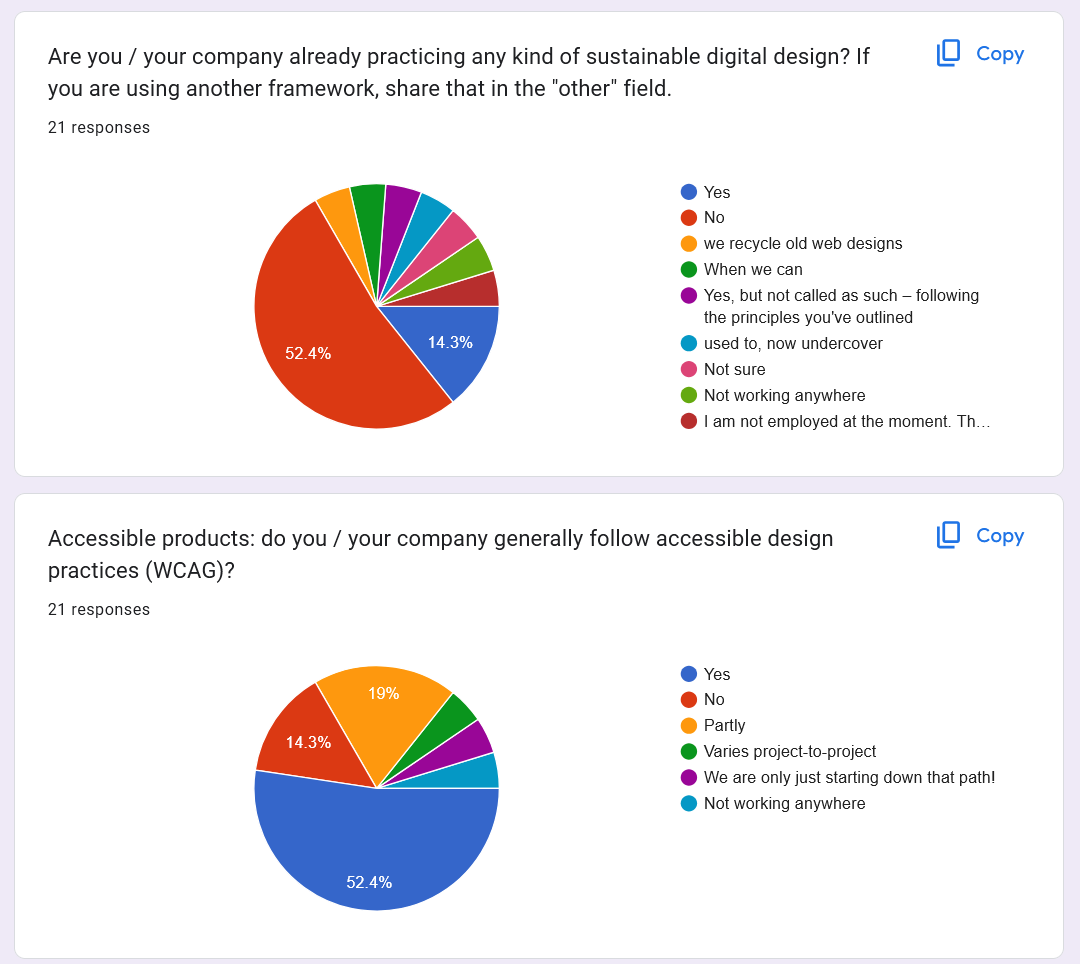You are probably already following >30% of the Web Sustainability Guidelines (talk recap + poll results)
This issue:
Climate Conversation Recap (Web Sustainability Guidelines Rosenfeld Media)
Reader survey - UX best practices
Live SustainableUX workshop - sign up
Last week I was a panelist on the latest Rosenfeld Climate Conversation, along with Ayaia Bodi from DrawDown and Marc O’Brian from Climate Designers. Most of this issue is a recap & extension of my short talk.
“You are probably already using most of the Web Sustainability Guidelines”
The Web Sustainability Guidelines (previously, previouslier) details “how to design and implement digital products and services that put people and the planet first”. This is a big document: there are 93 guidelines, including 29 UX-specific guidelines. That might seem overwhelming.
The good news: you are likely already following many of the WSG UX guidelines - even if your team has never heard of the WSG. For instance, several of the guidelines are pretty close to parts of the Web Content Accessibility Guidelines.
Which begs the question, how often are UX teams able to follow best practice recommendations? Horror stories abound: businesses cutting accessibility as a “nice to have”, stressed-out product owners nixing research in order to hit arbitrary deadlines, or your company cutting research altogether.
To try and understand this, I asked the audience how often they are able to apply best practice. From there, we can get a sense of how many of the WSGs are commonly being met through business-as-usual design.
Results below, plus a chance to take the new & improved survey.
UX Recommended Practices Survey 2.0
This is a slightly improved streamlined version of the survey - feel free to forward it to other UX folk. I’ll link to the results in the next newsletter.
Preliminary survey results on best practices
Accessibility: Do you / your team adhere to WCAG? 72% say yes, partly, or sometimes.
Performance: Does your team optimize the front-end experience? Only 23% answered “no.”
User and stakeholder research: Are teams generally able to carry out research? ~50% said yes (which isn’t awesome).
Bonus questions - what sustainability practices are you / your team already using?
Applying sustainable design principles at work: 14% yes, 52% no.
Green hosting: 23% yes, but most don’t know / unsure.
Comparing WSG guidelines to best practices
Accessibility: 5 matching UX guidelines (+6 from other sections of the WSG)
Caveat: WSG and WCAG guidelines can sound similar but may have important differences.
The WSG guidelines:
2.8 Ensure Navigation and Way-Finding Are Well-Structured. Compare to WCAG: 3.2.3, Consistent Navigation
2.9 Respect the Visitor's Attention: a close match to WCAG 2.2.4, Interruptions
2.10 Use Recognized Design Patterns
2.19 Provide Suitable Alternatives to Web Assets
2.21 Support Non-Graphic Ways To Interact With Content
possibly others, like 2.6
WCAG also maps to WSG Section 3 - Web Development.
3.5 Ensure Your Solutions Are Accessible
3.8 Use HTML Elements Correctly
3.11 Validate Form Errors and External Input
3.12 Use Metadata Correctly
3.13 Adapt to User Preferences
3.14 Develop a Mobile-First Layout
…and maybe others.
Performance: 7 UX guidelines (+11 web and infrastructure)
I count 7 relevant UX guidelines, 4 in the Web Dev section, and 7 in the Infrastructure section.
“Don’t be an asshole”: 3
I didn’t ask the audience about the level of user-hostile design in their products, but lets assume most of us adhere to these principles most of the time:
2.9 Respect the Visitor's Attention
2.11 Avoid Manipulative Patterns
2.14 Write With Purpose, in an Accessible, Easy To Understand Format
see also: much of Section 5, Business Strategy and Product Management
Research: 6
Including stakeholder interviews, up-front research, and formative usability.
It’s easier to count the guidelines you AREN’T following
If you are following a robust UX process, regardless of sustainability guidelines, you could be meeting 26 out of 29 UX guidelines in the WSG. The remainder:
2.1 Undertake Systemic Impacts Mapping
2.3 Research Non-Visitor's Needs
2.4 Consider Sustainability in Early Ideation
More on these three soon.
Looking at the whole of the WSG
The survey was focused on the UX section of the WSG, which accounts for 29 out of the 93 guidelines.
Looking at the entire list of 93 guidelines, I see maybe 60 that are accepted best practice outside of the sustainability world. To check, I polled a couple of developer friends on which guidelines looked like recommended practice.
Web development: 23 out of 24 guidelines would be familiar to front-end teams already. The one exception: “3.21 Align Technical Requirements With Sustainability Goals”.
Infrastructure: 11 out of 12. The exception: “4.1 Choose a Sustainable Hosting Provider”.
Unfortunately…
Section 5: Business Strategy and Product Management. 0 out of 29 (pessimistically). If you are a B-Corp, you might hit on several of these, but for the average (American) company, the score will be much lower.
Some thoughts
We can’t always follow best practice
As the poll results show, even when we know about best practices, we don’t always follow them, for a variety of reasons. That’s normal.
Where you work makes all the difference
A full one-third of the guidelines are difficult or impossible to meet unless your business adopts certain sustainability policies. How designers are meant to influence business is a whole other topic.
Stealthy sustainability
The great thing about best practices is that they are typically evidence-based. They might save teams from rework, they might be legal requirements, they might be great for users and profits, and so on. Therefore, it should be much easier to get your business to adopt them - you don’t have to mention sustainability.
Survey reminder
I have a fresh version of the survey for readers to try: UX best practices survey
SustainableUX Live event signup: WSG implementation workshop
I feel like throwing a workshop - wanna come? Topic: how to implement the WSG. It would have a strong focus on those parts of the WSG that UX folks might be less familiar with. How do we “Undertake Systemic Impacts Mapping”? What do non-visitors need, anyway? What does an end-of-life plan look like, for a website?
Thanks for reading!
Upcoming issues: the long-delayed conclusion to my newsletter migration story.






